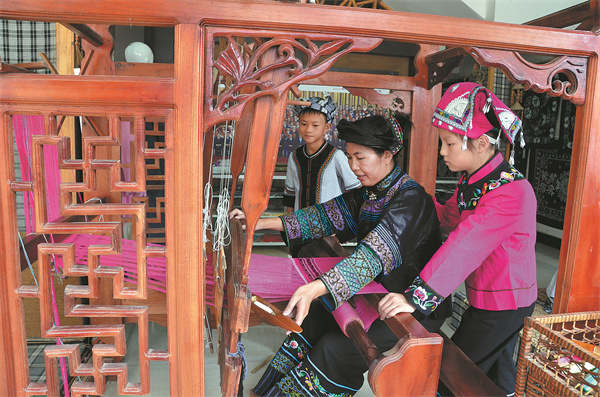

Inheritor dedicates herself to innovating Bouyei ethnic costumes and their elements drawn from the natural world, to keep pace with the times, Yang Feiyue reports.
Blue turban, greenish-blue collarless lapel jacket, a pleated skirt and a pair of embroidered shoes with pointed toecaps — a Bouyei woman, with her distinctive traditional ethnic costume, is easy to spot.
Local ethnic women have carried forward the traditional art that bears the love of their mothers and was named a national intangible cultural heritage by the State Council in 2014.
They have also weaved in new elements to help the art keep pace with the times and appeal to the younger generation.
Wang Jing is one of them.
The woman from Xingyi city, the Qianxinan Bouyei and Miao autonomous prefecture of southwestern China's Guizhou province, has given up many lucrative opportunities, choosing to stay in her hometown and imbue the traditional ethnic clothing with an innovative spirit.
Wang, in her early 50s, had been snowed under with orders for ethnic clothes since the fourth quarter of last year, especially during the build-up to Spring Festival.
"Most of those traditional costumes were requested by locals who want to wear them for the holiday or other celebrations, like weddings," Wang says.
A considerable number of them were for travelers who will wear them and experience local folk customs, she adds.
In Wang's workshop in Xingyi, polychromatic clothes featuring various local ethnic elements abound.
"My business is about making ethnic costumes specific to Guizhou, but mainly the Bouyei ones," Wang says.
"We want people to learn about and understand the ethnic costumes and we want to pass on this craftsmanship."
Wang has made a point of injecting modern aesthetics into the traditional costume craft while retaining the vital traditional elements.
"I've made a few upgrades to the traditional cut," she says.
For instance, Wang has taken in the sleeves and waist areas to accentuate the curves of the female form. She also broke new ground by sewing on the waistband.
"This way, it saves the trouble of taking it on and off every time you need to change clothes," she explains.
Moreover, Wang has created more color combinations, which have proved popular with local ethnic women, especially those of the younger generation.
Such adjustments have made her costumes very popular across the province.
However, she has made sure the traditional patterns and main colors are not compromised.
"Generally speaking, flowers, birds, fish and insects are major totems on Bouyei costumes," Wang says, adding that they are things worshiped by Bouyei people, who protect the local ecology and care for the environment.
"They all originated from nature and have been artistically processed to evolve into the patterns we see today."
Ethnic costume styles vary with the local environment.
"For example, aquatic animals like fish and shrimp have emerged more in embroideries near the Nanpan River, while those originating in mountainous areas feature flowers, grasses, bamboo and banana leaves," Wang explains.
Born into a Bouyei family, Wang grew up wearing the traditional clothing, which was made by her grandmother and mother.
"I would sit on a small stool and watch the polychromatic threads traveling through their hands," she recalls.